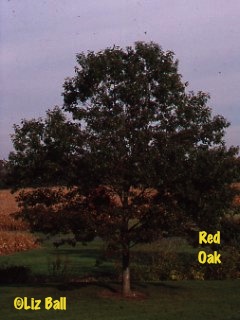 Northern Red Oak (Quercus rubra) in the Red Oak family
Northern Red Oak (Quercus rubra) in the Red Oak family
The Red Oak is grown widely in this country in residential yards and along streets, and for good reason. It is easy to grow, resists many urban ills such as salt and pollution, tolerates heat and drought fairly well and supports a variety of wildlife.
Red Oaks are medium sized trees, growing from 60 to 75 feet tall at maturity. Their large canopy typically spreads 45 feet or more, about 3/4 of their height, especially if they are grown in the open. Their growth rate is medium, about 2 to 3 feet a year over their youthful first 10 years, then 1 1/2 to 2 feet a year. Red Oaks routinely live up to 300 years.
Red Oaks grow successfully further north than most other Oaks. They are hardy to up to the Canadian border (zone 4). They are able to withstand winter temperatures as low as -30° F. The Red Oak variety that grows in the south thrives well into Texas and through the Gulf states (zone 8).
Red Oak foliage emerges in May fuzzy reddish or pink, turning light green, then darker green as the summer progresses. In the fall the leaves put on a golden display before dropping in mid November or so. Red Oak leaves are 4 to 8 inches long and 2 to 4 inches wide. They have from 7 to 11 deeply cut lobes that are pointed, almost spiny, at their tips (distinguished from White Oak leaves that have fewer lobes and rounded tips). The leaves are somewhat dull on the surface, pale yellowish-green beneath.
Red Oaks produce male flowers called catkins. They appear in May just after the leaves emerge in yellow-green hanging clusters, 3 to 4 inches long. Inconspicuous female flowers grow where the leaf stems join the twigs. By September or early October these have given way to broad, dark brown acorns that are from 3/4 to 1 1/4 inches long. Their saucer-like caps cover a very small portion of the acorn. Sometimes these acorns are wooly. They grow either alone or in pairs on the twigs. The nut within the acorns is coveted by songbirds, ground birds, small mammals like squirrels and chipmunks and even deer.
For folks living in the south with somewhat wet soils, the Shumard’s Red Oak resembles the Northern Red Oak in appearance, size and fall color. For dry soils in the South, try the Southern Red Oak which has dark=-green glossy leaves that change to red-orange in autumn.
Red Oak Choices
Rubra is best suited to southern regions. Maxima is also called Northrn Red Oak, and is most common in northeastern regions where it is a fast grower and displays beautiful red foliage in the fall. Aurea is a variety that has yellow spring growth.

